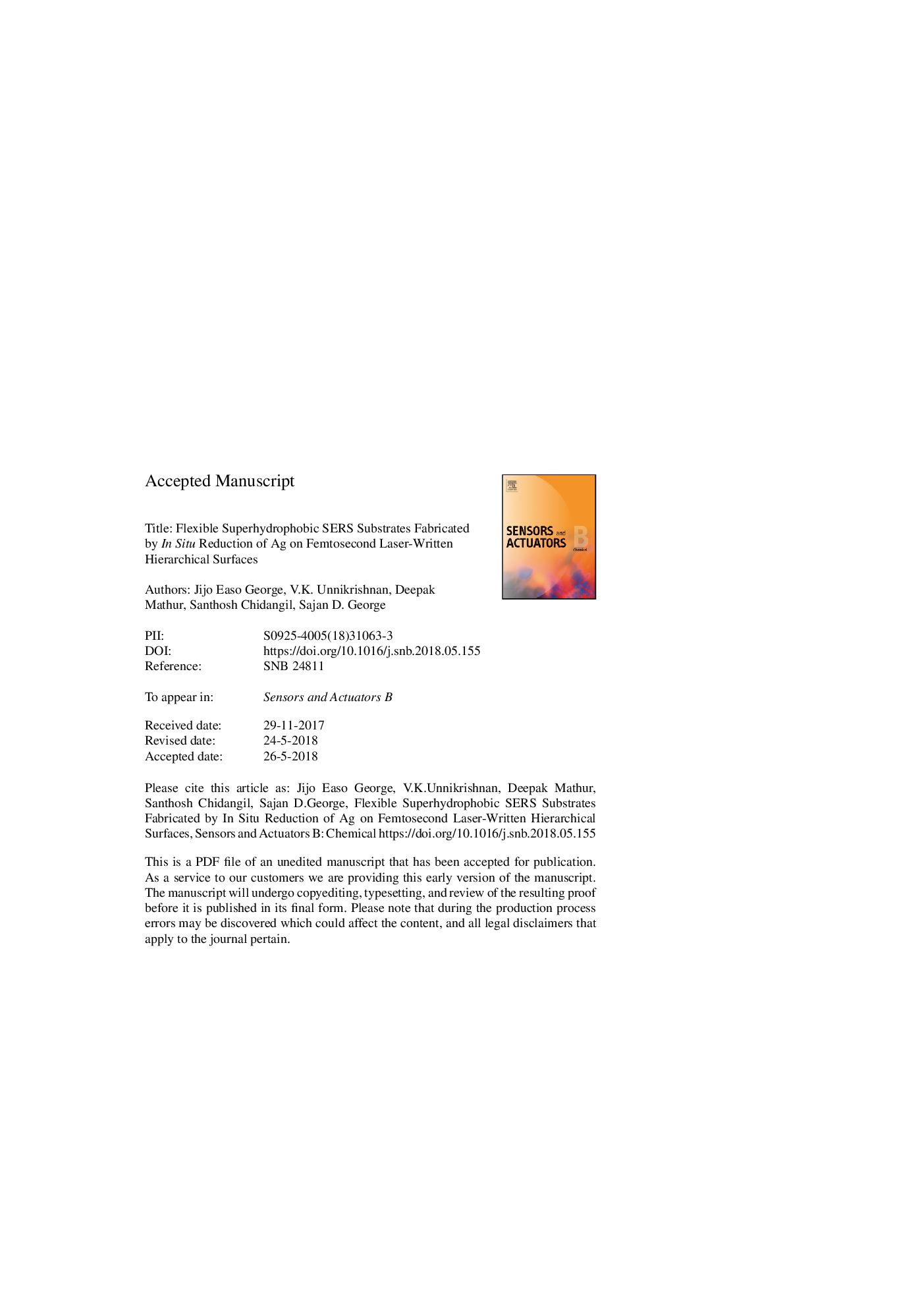| کد مقاله | کد نشریه | سال انتشار | مقاله انگلیسی | نسخه تمام متن |
|---|---|---|---|---|
| 7138945 | 1462017 | 2018 | 25 صفحه PDF | دانلود رایگان |
عنوان انگلیسی مقاله ISI
Flexible superhydrophobic SERS substrates fabricated by in situ reduction of Ag on femtosecond laser-written hierarchical surfaces
دانلود مقاله + سفارش ترجمه
دانلود مقاله ISI انگلیسی
رایگان برای ایرانیان
کلمات کلیدی
CAHΘaLiquid surface tensionAverage roughnessRh6GFemtosecond laser writingPDMSθrSERSSuperhydrophobicity - بساآبگریزی، اَبَرآبگریزیRhodamine 6G - رودامین ۶جیroot mean square roughness - ریشه متوسط زبری دانهReceding contact angle - زاویه تماس زدنApparent contact angle - زاویه تماس ظاهریAdvancing contact angle - زاویه تماس پیشرفتهsurface enhanced Raman scattering - سطح افزایش پراکندگی رامانEnhancement factor - ضریب افزایشMethyl orange - متیل اورانژContact angle hysteresis - هیسترزیس زاویه تماسPMMA - پلی (متیل متاکریلات) polymethylmethacrylate - پلی اتیل متاکریلاتPolydimethylsiloxane - پلیمتیلسیلوکسان
موضوعات مرتبط
مهندسی و علوم پایه
شیمی
شیمی آنالیزی یا شیمی تجزیه
پیش نمایش صفحه اول مقاله

چکیده انگلیسی
The ability to fingerprint a few molecules via surface enhanced Raman scattering (SERS) continues to be of considerable utility in diverse fields encompassing physics, chemistry, materials sciences, nanotechnology, biomedicine, and environmental engineering. However, the development of facile and low cost approaches towards the fabrication of flexible substrates with very high SERS signal enhancement remains a challenge. Compared to conventional plasmonic-based sensors, a superhydrophobic plasmonic surface provides the combined advantage of concentration enrichment of solute molecules, the fourth power dependent localized electric field enhancement as well as the enhanced light scattering on rough surface. We demonstrate here a method to fabricate flexible SERS substrates by replicating laser-written patterns created on polymethylmethacrylate (PMMA) onto a soft-elastomer, namely polydimethylsiloxane (PDMS), followed by in situ reduction of silver nanoparticles on the surface. Laser writing of structures is fluence dependent and leads to substantial enhancement of Raman signals compared to a conventional plasmonic surface. Our fabricated surfaces provide a limit of detection of eight femtomolar for Rhodamine 6G upon 532â¯nm resonance excitation; an enhancement factor of â¼1010 is achieved for methyl orange. Studies of how water droplets spread on our laser-written surfaces indicate a fluence dependent enhancement in apparent contact angle with a concomitant increase in the contact angle hysteresis (CAH). Most significantly, our replicated patterns exhibit lotus effect (superhydrophobic surface with ultra-low contact angle hysteresis), that upon reduction of silver nanoparticles, exhibit superhydrophobicity with high contact angle hysteresis (rose petal effect). Our findings offer fresh opportunities for expanding the applicability of the SERS technique via superhydrophobic flexible plasmonic nanostructures.
ناشر
Database: Elsevier - ScienceDirect (ساینس دایرکت)
Journal: Sensors and Actuators B: Chemical - Volume 272, 1 November 2018, Pages 485-493
Journal: Sensors and Actuators B: Chemical - Volume 272, 1 November 2018, Pages 485-493
نویسندگان
Jijo Easo George, V.K. Unnikrishnan, Deepak Mathur, Santhosh Chidangil, Sajan D. George,